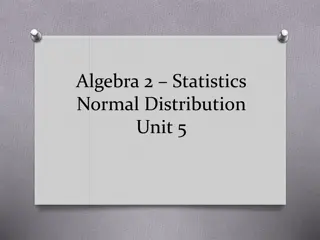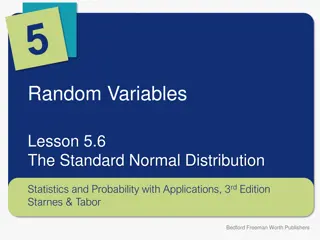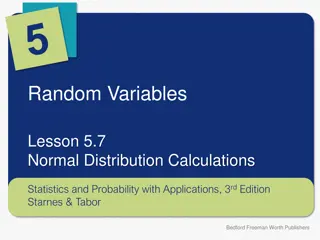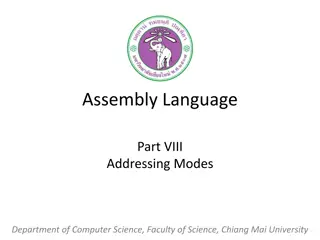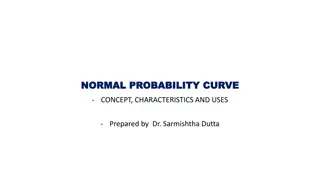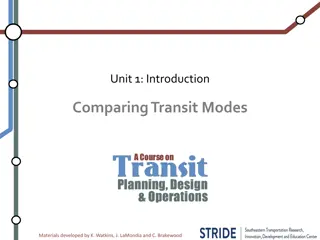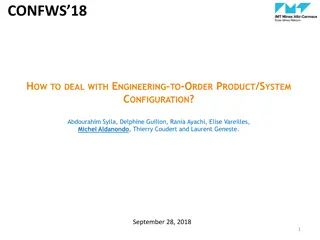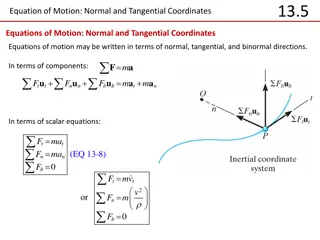Managing Higher-order Modes in Normal Conducting RF Technology
The excitation of higher-order transverse modes due to misalignments between the beam and RF structures can lead to beam instability in linear colliders. This instability can be mitigated by selectively damping the transverse modes and/or detuning the dipole mode frequencies. Understanding the differences in modes and applying damping and detuning techniques effectively are crucial for maintaining beam stability in normal conducting RF systems.
Download Presentation

Please find below an Image/Link to download the presentation.
The content on the website is provided AS IS for your information and personal use only. It may not be sold, licensed, or shared on other websites without obtaining consent from the author. Download presentation by click this link. If you encounter any issues during the download, it is possible that the publisher has removed the file from their server.
E N D
Presentation Transcript
Course B: rf technology Normal conducting rf Part 5: Higher-order-mode damping Walter Wuensch, CERN Sixth International Accelerator School for Linear Colliders 10-12 November 2011 1
The fundamental issue: Misalignments between the beam and rf structures will result in the excitation of higher-order transverse modes. For example TM110-like modes. Because linear collider beams consist of trains of bunches, these modes which are excited by a bunch, will act on following bunches. Because the modes are transverse, they will cause deflections of following bunches. And because the beam is intense, in order to have high efficiency, this effect is quite strong. Hence we have the potential for a transverse instability. There are also high-order longitudinal modes which affect energy spread but we will not speak much about them they mostly get taken care of automatically. Higher order mode Beam direction and axis 2
In order to prevent the beam instability, we need to act on the transverse mode while minimizing the effect on the fundamental, accelerating, mode. We can do this in two ways. 1. Selectively damp the transverse, higher-order, modes. This means adding features to the cells which selectively couple to the unwanted modes. Lowering their Q so the amplitude of the mode is suppressed between bunches. In a linear collider this means reducing the dipole mode Q s to values below 10. 2. Messing around with the dipole mode frequencies, while leaving the fundamental unchanged, so that bunches get kicks from different parts of the structure with different phases. This causes a net wakefield cancellation and is called detuning. In reality we almost always do a bit of both. In order to do this in practice we need to address the question: How do the modes differ? Damping first. Then detuning. 3
What the modes look like: Transverse, m=1 mode longitudinal, m=0 mode surface electric field f=11.994 GHz f=18.014 GHz surface magnetic field
Dispersion curves: Mid cell Third dipole We of course need to consider the beam/mode interaction in multi cell structures. Consequently we go back to dispersion curves, Brillouin diagrams. Here we see the synchronous crossings of the dispersion curves with the speed of light line. Second dipole First dipole Light line Monopole Thanks to Vasim Khan for the detuning plots!
Not all of the modes kick equally. The mode characteristics of disk loaded waveguide are complicated hybrids of more TM-like and more TE-like hybrids.
The types of modes differ in both frequency and symmetry. Lets consider their difference in frequency first. The most straightforward way of selectively damping is to introduce a waveguide into the cell which has a cutoff frequency above the fundamental mode, 12 GHz in our example, but below the lowest dipole mode, 18 GHz. Fundamental mode power is in cut-off so does not propagate, dipole mode power does. This is called waveguide damping and is used in the CLIC baseline structure. We ll look more closely at the CLIC structure now, to get the bigger picture of a damped structure before moving on to the other types of wakefield suppression. 7
Waveguide damped cell topology The cells have 11 mm wide waveguides. This gives a cutoff frequency of 13.6 GHz for the TE1,0 which is given by the relation:a c 2 0= f 18 GHz propagates, 12 GHz is in cut-off. The Q of the dipole mode is around 10. 8
Frequency and time behavior t 1 0 f ( ) 2 ( ) E f 2 Q = E e 0 Q 2 f ( ) f 2 + f f f 0 0 2 Q CLIC bunch spacing f0=18 GHz, Q=10 10 1 0.1 1 0.01 Esquare f ( ) Ampl t ( ) 3 1 10 0.1 4 1 10 5 1 10 0.01 0 0.5 1 1.5 2 10 15 20 25 t f 9 [GHz] [ns]
How it looks 11
Then you need to terminate each waveguide with an absorbing load XY Plot 2 Ansoft LLC ANSOFT 0.00 Curve Info dB(S(WavePort1:1,WavePort1:1)) dB(S(WavePort1:2,WavePort1:2)) -10.00 -20.00 S11 [dB] -30.00 -40.00 -50.00 -60.00 15.00 20.00 25.00 30.00 35.00 40.00 Freq [GHz] 12
You can make a pretty good approximation to the wakefield from a heavily damped structure by getting frequencies from an undamped dispersion curve and Q s from an eigenvalue solver. But in practice the wakefield from such a structure is solved using a time domain code. 3 10 WX WY 2 10 WT [V/pC/mm/m] 1 10 0 10 -1 10 0 0.15 0.3 0.45 s [m] 0.6 0.75 0.9 13
There is however a price to pay for including damping. You lose a bit in shunt impedance. There is a concentration of surface magnetic field on the outer cavity wall, which can cause problems at high power. Mechanical complexity milling is required. Es/Ea Hs/Ea 14
Now we will consider damping which takes advantage of the different symmetry of the monopole and dipole modes. Another way of saying it is that we will take advantage of the different field patterns of the two modes. The form of damping is called slotted-iris damping. This type of damping is used in the CTF3 drive beam linac accelerating structures, in the CLIC PETS structures and has been considered as a alternative CLIC main linac structure. 15
Slotted iris damping put slot here surface current 16 16 16 16
Hybrid Damped Structure (HDS) Combination of slotted iris and radial waveguide (hybrid) damping results in low Q-factor of the first dipole mode: ~ 10
Surface electric field Surface magnetic field 18
Slotted iris damping in the CLIC PETS structures Q s below 10 20
Detuning Introduce a variation in the dimensions of a structure such that the fundamental, accelerating mode synchronous frequency is unchanged, but higher order modes are detuned. Remember these figures from part 1? 12.5 11.875 frequency [GHz] 11.25 10.625 10 0 30 60 90 120 150 180 22 phase advance per cell [degrees]
How it looks 23
Detuning Monopole Third dipole Second dipole Last cell First dipole Monopole Mid cell First cell
Detuning close upon dipole modes Third dipole Lowest dipole band Dipole bands Last cell Mid cell Second dipole First cell First dipole
From these dispersion curves we get the frequency spectrum of the transverse modes, from which we can determine the time dependence through the Fourier transform: t sin 0 t0 2 t 0 1.0 2 1.0 0.8 0.8 0.6 0.6 0.4 0.4 0.2 0.2 5 5 0.2 1.0 0.5 0.5 1.0 Broader spectrum gives faster roll-off. 26
Lowest dipole band No tapering (Qcu = 6500) No. of Cells =24 Linear tapering (Qcu = 6500) No. of Cells =196 (8 structures)
Putting damping and detuning together Cell First Middle Last Q-factor 11.1 8.7 7.1 Amplitude [V/pC/mm/m] 125 156 182 Frequency [GHz] 16.91 17.35 17.80 3 15 10 first cell middle cell last cell WX WY 2 10 {ZT} [kOhm/m/mm] WT [V/pC/mm/m] 10 1 10 5 0 10 -1 10 0 0 0.15 0.3 0.45 s [m] 0.6 0.75 0.9 0 10 20 30 40 50 60 f [GHz] 28
Another way of taking advantage of the frequency difference choke mode damping. Basic idea: Put in a slot around the structure to let all modes out. Add a choke (a sort of narrow band-stop filter which acts like a short circuit) to keep the fundamental mode in. This is another example where frequency selection is used. 30
Damping simulation with Gdfidl/HFSS Good damping for first dipole Mode reflected by the choke, to be studied Gap 1mm 2mm 40 gap 1mm gap 1.5mm gap 2mm 30 Zy / k /m/mm 20 10 0 Impedance and wakefield simulated in Gdfidl -10 0 10 20 30 40 50 60 70 80 90 f / GHz 103 E field, fundamental mode gap 1mm gap 1.5mm gap 2mm 102 Wy / [V/pC/m/mm] 101 100 (Model in HFSS) 10-1 E field of a dipole mode that is reflected by the choke 32 0 0.2 0.4 0.6 0.8 1 1.2 1.4 1.6 1.8 2 s / m Jiaru Shi, LCWS11 Workshop, Granada
Elliptical-rod Design at 11 GHz Standing wave design with 2 matching cells, one test cell Axially powered via TM01 mode launcher Structure has elliptical inner rods Spread large H field over larger region reduce pulsed heating Performance at 100 MV/m Rod Spacing Round Elliptical Power 5.9 MW 4.4 MW Outer Rod Radius Peak Surface E Field 208 MV/m 207 MV/m Minor Radius Major Radius Peak Surface Magnetic Field 890 kA/m 713 kA/m Pulsed Heating for 150ns Flat Pulse 131 K 84 K B. J. Munroe, MIT


